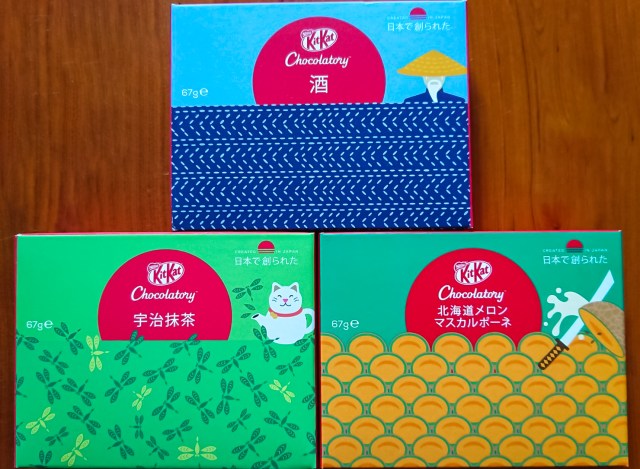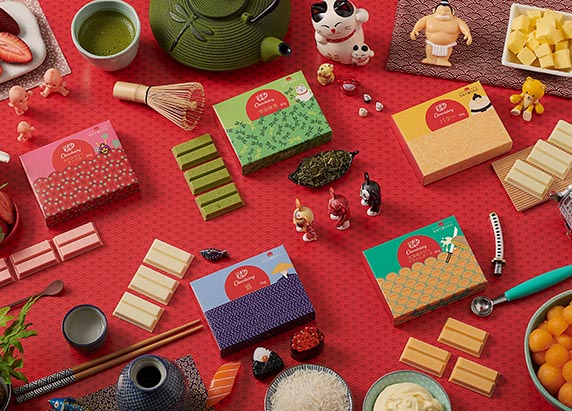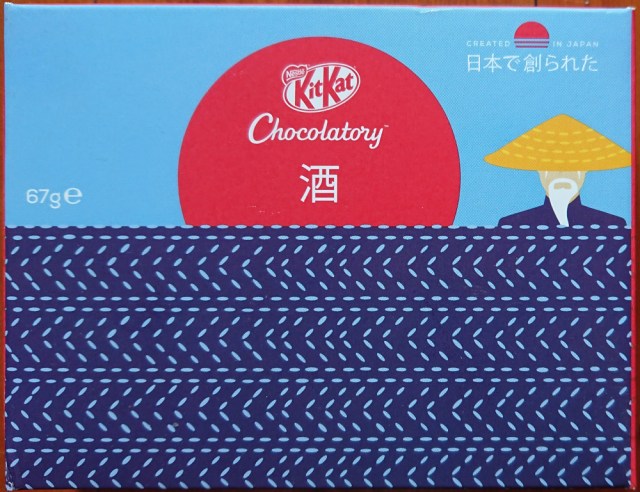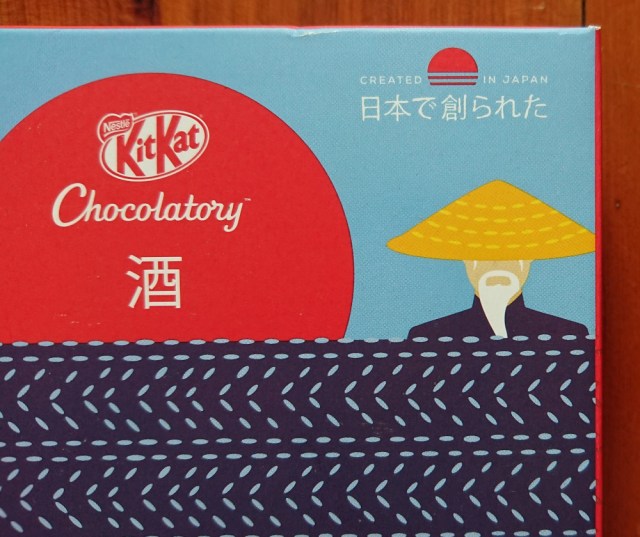
Pssst, Nestlé — that character’s not Japanese and you’re playing into problematic Asian stereotypes.
Asian representation in the mainstream media has been sorely lacking over the years, and the struggle to move past stereotypical depictions has been another hurdle to overcome for members of the Asian community.
The stereotypical image of the Chinese kung fu master, for instance, is one that continues to pop up in the West as a catchall for the Asian mystique, but within Asia, there’s a clear understanding that this doesn’t represent all of Asia, but merely one nation within it.
That’s because within Asia, there’s a clear understanding that not all Asian countries are the same. In fact, using an often-seen image from one country to represent another can be seen as offensive, which leads us to the question…why did Nestlé Australia choose to do it?
The image in question appeared on one of the products in the “Created in Japan” series available exclusively at the KitKat Chocolatory in Melbourne. The collection consisted of five flavours: Butter, Hokkaido Melon & Mascarpone, Uji Matcha, Strawberry & Maple, and Sake.
▼ Nestlé Australia’s “Created in Japan” series

This series features KitKat flavours that are usually only available exclusively in Japan. However, the boxes they’re packaged in have been specially designed for the Australian market, featuring Japanese icons such as a sumo wrestler, a samurai warrior, a maneki neko cat, a samurai sword, and…a Chinese rice farmer?
That’s right, the KitKat Chocolatory Sake flavour features a design that depicts what looks to be a rice field, as a nod to the fact that sake is made from rice. The image on the right-hand side of the box, however, is confusing, as it shows what appears to be a man with a long, thin white beard and moustache, wearing a conical hat and a top with a high collar.
To people in Japan, this image doesn’t look Japanese. Though conical hats like these are sometimes worn in the fields, it’s far more common to see farmers wearing baseball caps, cloth hats, or towels around their heads in Japan. What’s most unusual is the long, thin white beard and moustache, which conjures up images of Pai Mei, the kung fu master played by Chinese actor Gordon Liu in the Hollywood movie Kill Bill.
Kill Bill Vol. 2 - the scene with Beatrix buried alive 😳😳😳🤯🖤🖤🖤
— Steph 💫 BLM (@stephanie9303d) May 1, 2021
Loved the old Bruce Lee movie vibes and Pai Mei pic.twitter.com/cYRu47or1e
Facial hair may be a common sight in some Asian countries, but not in Japan, where you could live a whole lifetime without encountering a single individual with a long, white beard like this one. Adding to the confusion is the fact that, like Pai Mei, the figure on the KitKat box wears an outfit with a stand-up mandarin collar, so-called as it was part of the uniform worn by mandarin bureaucrats in Qing-era China.
▼ The recipe for the chocolate inside the box may be “Created in Japan” but this image certainly isn’t.
We put the question out to expats in Japan, asking them whether they thought this image looked like a Japanese person, and this is what they said:
“Not at all. Unless it’s changed all of a sudden, during my 15+ years’ stay in Japan — three of which was in the sticks — I’ve never met, seen or heard of an old man with a sedge hat and a white beard like Master Pai Mei. If the question was about a “stereotypical Asian person”, then yes.”
“No. Not Japanese, but rather Chinese, because of the ’60s/’70s kung fu movie tropes.”
“It looks quite Vietnamese to me, a Vietnamese. Like an illustration from my elementary school textbook.”
“Not Japanese because of the hat (the traditional Japanese hat is way different) and the beard is not to be seen in Japan. Looks Chinese to me. The clothes reinforce the idea of a Chinese man with the Mandarin collar.”
“Nope. Vietnamese. I lived in Japan for almost twenty years and have travelled through Vietnam on two occasions. No question. Not Japanese in my opinion.”
“The hat looks south-east Asian while the beard makes me think Chinese. The overall effect makes me think ‘overconfident white person’s interpretation of a generic Asian’.”
When our Japanese reporters saw the image, this is what they had to say:
“Personally, the beard and clothes make it feel like it’s a Chinese sage.”
“I don’t think it’s Japanese. The high collar that covers the neck and the hat shape give off the impression of China.”
“In Japan, you wouldn’t sell a product with a red sun image on it like this because of its political implications.”
“It looks like a Vietnamese person.”
“Looks like a Chinese person. It also has the Chinese character for ‘alcohol’ (not “sake’), which makes me think that even more.”
“From a distance, I get the impression that it’s Japanese because of the red sun image. But when you get closer, the “Japan” element decreases by 50 percent.”
“I wonder if it was made by a non-Japanese person who imagined Japan. That’s why “Created in Japan” was added as a supplement.”
So what about Nestlé Australia? We asked their Corporate Affairs Manager a series of questions about the design, including whether any Asian staff had been involved in its creation or if they had consulted anyone from Nestlé Japan or the local Japanese community before selling the product, and they simply said:
“I can confirm that this product has been deleted and there are no plans for it to be brought back at this stage.
It was certainly not our intention to cause offence and I have shared your concerns with our marketing team.”
While it’s true that the product was taken off the market in Australia recently, Nestlé Australia failed to explain the reason why it had been deleted. With demand for Japanese KitKats remaining strong around the world, it would be nice to see the Sake KitKat return to the market in Australia, and other countries too, but next time in more culturally appropriate packaging.
Source: Nestlé Australia
Featured image © SoraNews24
Insert images © SoraNews24 unless otherwise stated
● Want to hear about SoraNews24’s latest articles as soon as they’re published? Follow us on Facebook and Twitter!



 Yoghurt Sake is the newest Japanese KitKat we need to get our hands on right now
Yoghurt Sake is the newest Japanese KitKat we need to get our hands on right now New Japanese KitKats capture the flavour of a busy port city
New Japanese KitKats capture the flavour of a busy port city New Volcanic Japanese KitKats unveiled at star-studded Tokyo event
New Volcanic Japanese KitKats unveiled at star-studded Tokyo event New Japanese KitKat is…a Heartful Bear!
New Japanese KitKat is…a Heartful Bear! New Japanese KitKat captures the flavour of Baskin Robbins’ choc mint ice cream
New Japanese KitKat captures the flavour of Baskin Robbins’ choc mint ice cream Foreigner’s request for help in Tokyo makes us sad for the state of society
Foreigner’s request for help in Tokyo makes us sad for the state of society Japanese city loses residents’ personal data, which was on paper being transported on a windy day
Japanese city loses residents’ personal data, which was on paper being transported on a windy day Seaside scenery, history, and so many desserts on Yokohama’s Akai Kutsu【Japan Loop Buses】
Seaside scenery, history, and so many desserts on Yokohama’s Akai Kutsu【Japan Loop Buses】 Doraemon found buried at sea as scene from 1993 anime becomes real life【Photos】
Doraemon found buried at sea as scene from 1993 anime becomes real life【Photos】 Japanese ramen restaurants under pressure from new yen banknotes
Japanese ramen restaurants under pressure from new yen banknotes Should you add tartar sauce to Japanese curry rice? CoCo Ichi makes diners an unusual offer
Should you add tartar sauce to Japanese curry rice? CoCo Ichi makes diners an unusual offer Smash Bros. director Sakurai stabs Kirby in the face, has delicious justification for it
Smash Bros. director Sakurai stabs Kirby in the face, has delicious justification for it NHK bill collector arrested for kissing woman on the job: “I thought we were hitting it off!”
NHK bill collector arrested for kissing woman on the job: “I thought we were hitting it off!” We try five menu recommendations from a clerk at CoCo Ichibanya and almost fall in love
We try five menu recommendations from a clerk at CoCo Ichibanya and almost fall in love Why Japanese doesn’t need swear words
Why Japanese doesn’t need swear words McDonald’s new Happy Meals offer up cute and practical Sanrio lifestyle goods
McDonald’s new Happy Meals offer up cute and practical Sanrio lifestyle goods French Fries Bread in Tokyo’s Shibuya becomes a hit on social media
French Fries Bread in Tokyo’s Shibuya becomes a hit on social media Studio Ghibli releases new action figures featuring Nausicaä of the Valley of the Wind characters
Studio Ghibli releases new action figures featuring Nausicaä of the Valley of the Wind characters Red light district sushi restaurant in Tokyo shows us just how wrong we were about it
Red light district sushi restaurant in Tokyo shows us just how wrong we were about it New private rooms on Tokaido Shinkansen change the way we travel from Tokyo to Kyoto
New private rooms on Tokaido Shinkansen change the way we travel from Tokyo to Kyoto Tokyo Tsukiji fish market site to be redeveloped with 50,000-seat stadium, hotel, shopping center
Tokyo Tsukiji fish market site to be redeveloped with 50,000-seat stadium, hotel, shopping center Beautiful Ghibli sealing wax kits let you create accessories and elegant letter decorations【Pics】
Beautiful Ghibli sealing wax kits let you create accessories and elegant letter decorations【Pics】 Studio Ghibli releases Kiki’s Delivery Service chocolate cake pouches in Japan
Studio Ghibli releases Kiki’s Delivery Service chocolate cake pouches in Japan New definition of “Japanese whiskey” goes into effect to prevent fakes from fooling overseas buyers
New definition of “Japanese whiskey” goes into effect to prevent fakes from fooling overseas buyers Our Japanese reporter visits Costco in the U.S., finds super American and very Japanese things
Our Japanese reporter visits Costco in the U.S., finds super American and very Japanese things All-you-can-drink Starbucks and amazing views part of Tokyo’s new 170 meter-high sky lounge
All-you-can-drink Starbucks and amazing views part of Tokyo’s new 170 meter-high sky lounge More foreign tourists than ever before in history visited Japan last month
More foreign tourists than ever before in history visited Japan last month New Pokémon cakes let you eat your way through Pikachu and all the Eevee evolutions
New Pokémon cakes let you eat your way through Pikachu and all the Eevee evolutions Disney princesses get official manga makeovers for Manga Princess Cafe opening in Tokyo
Disney princesses get official manga makeovers for Manga Princess Cafe opening in Tokyo Sales of Japan’s most convenient train ticket/shopping payment cards suspended indefinitely
Sales of Japan’s most convenient train ticket/shopping payment cards suspended indefinitely Sold-out Studio Ghibli desktop humidifiers are back so Totoro can help you through the dry season
Sold-out Studio Ghibli desktop humidifiers are back so Totoro can help you through the dry season Japanese government to make first change to romanization spelling rules since the 1950s
Japanese government to make first change to romanization spelling rules since the 1950s Ghibli founders Toshio Suzuki and Hayao Miyazaki contribute to Japanese whisky Totoro label design
Ghibli founders Toshio Suzuki and Hayao Miyazaki contribute to Japanese whisky Totoro label design Tokyo’s most famous Starbucks is closed
Tokyo’s most famous Starbucks is closed One Piece characters’ nationalities revealed, but fans have mixed opinions
One Piece characters’ nationalities revealed, but fans have mixed opinions We asked a Uniqlo employee what four things we should buy and their suggestions didn’t disappoint
We asked a Uniqlo employee what four things we should buy and their suggestions didn’t disappoint Princesses, fruits, and blacksmiths: Study reveals the 30 most unusual family names in Japan
Princesses, fruits, and blacksmiths: Study reveals the 30 most unusual family names in Japan New Japanese KitKat flavour, Sugar Butter Tree, is like cracking a chocolate tree branch
New Japanese KitKat flavour, Sugar Butter Tree, is like cracking a chocolate tree branch New Yuzu Sake KitKat combines Japanese rice wine with a zesty local citrus
New Yuzu Sake KitKat combines Japanese rice wine with a zesty local citrus New Japanese KitKats combine ruby chocolate with everyday nuts and cranberry
New Japanese KitKats combine ruby chocolate with everyday nuts and cranberry We taste the new Japanese KitKat, aged in whisky barrels in Islay, Scotland
We taste the new Japanese KitKat, aged in whisky barrels in Islay, Scotland New winter-only Japanese KitKat flavour combines chocolate with a decadent sweet
New winter-only Japanese KitKat flavour combines chocolate with a decadent sweet Sakura Japanese Sake KitKats combine rice wine and cherry blossoms for a sweet hanami experience
Sakura Japanese Sake KitKats combine rice wine and cherry blossoms for a sweet hanami experience Mouthwatering Pokémon KitKat “ad” has us dreaming of the future of Japanese sweets【Video】
Mouthwatering Pokémon KitKat “ad” has us dreaming of the future of Japanese sweets【Video】 Taste the Earth with Japan’s new Sublime Volcanic KitKats
Taste the Earth with Japan’s new Sublime Volcanic KitKats New Japanese KitKat flavour stars Sanrio characters, including Hello Kitty
New Japanese KitKat flavour stars Sanrio characters, including Hello Kitty What some Japanese people think of China is as stereotypical as you can get
What some Japanese people think of China is as stereotypical as you can get World’s first make-your-own KitKat shop is opening in Tokyo
World’s first make-your-own KitKat shop is opening in Tokyo Gourmet birthstone Kit Kats go on sale in Japan, give us something to look forward to all year
Gourmet birthstone Kit Kats go on sale in Japan, give us something to look forward to all year New Japanese KitKats feature sakura sake and a traditional cherry blossom dessert
New Japanese KitKats feature sakura sake and a traditional cherry blossom dessert The newest must-eat Japanese KitKats: Deep-fried KitKat katsu on sticks
The newest must-eat Japanese KitKats: Deep-fried KitKat katsu on sticks Japanese KitKat Bears debut exclusively in Japan, but are they any good?
Japanese KitKat Bears debut exclusively in Japan, but are they any good?
Leave a Reply